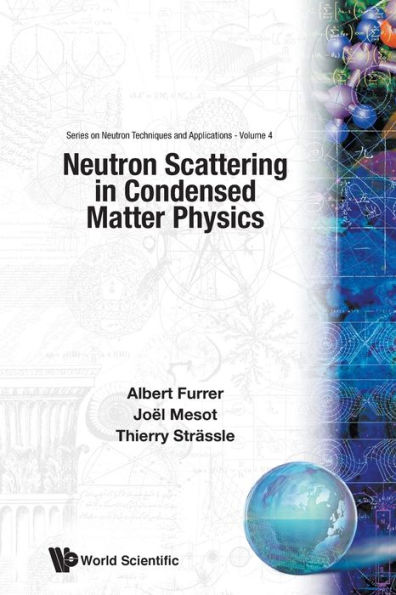Table of Contents
Preface v
1 Introduction 1
1.1 Why neutron scattering? 1
1.2 Basic properties of the neutron 2
2 Basic principles of Neutron Scattering 7
2.1 Aim of a neutron scattering experiment 7
2.2 Neutron scattering cross-section 8
2.3 Correlation functions 10
2.4 Coherent and incoherent scattering 12
2.5 Principle of detailed balance 14
2.6 Magnetic scattering 15
2.7 Polarized neutrons 19
2.8 Dynamical neutron scattering 21
2.9 Further reading 23
3 Instrumentation 25
3.1 Neutron sources 25
3.1.1 Historical evolution of neutron sources 25
3.1.2 Practical requirements for neutron sources 26
3.1.3 Fission sources 26
3.1.4 Spallation sources 27
3.1.5 Moderation of neutrons 29
3.2 Instrument component 30
3.2.1 Beam tubes and static collimators 30
3.2.2 Neutron guides 31
3.2.3 Time-of-flight monochromators 33
3.2.4 Monochromators (and analyzer) crystals 34
3.2.5 Neutron beam filters 37
3.2.6 Spin polarizers (and spin analyzers) 38
3.2.7 Guide fields and spin flippers 39
3.2.8 Detectors 40
3.3 Neutrons instruments 41
3.3.1 Introductory remarks 41
3.3.2 Powder diffractometers 42
3.3.3 Single-crystal diffractometers 43
3.3.4 Small-angle scattering instruments 45
3.3.5 Reflectometers 46
3.3.6 Time-of-flight spectrometers 48
3.3.7 Triple-axis spectrometers 50
3.3.8 Backscattering spectrometers 51
3.3.9 Spin-echo spectrometers 52
3.4 Sample environment 54
3.4.1 Temperature 54
3.4.2 Magnetic field 56
3.4.3 Pressure 57
3.5 Further reading 61
4 Structure Determinations 63
4.1 Cross section 63
4.2 Examples of structure factors 65
4.3 Polycrystalline materials 66
4.4 Single crystals 69
4.4.1 Rotating crystal method70
4.4.2 Laue method 70
4.5 Extinction and absorption 71
4.6 Characterization of residual stress 73
4.7 Further reading 74
4.8 Exercises 76
4.9 Solutions 79
5 Lattice Dynamics 85
5.1 Cross section for one-phonon scattering 85
5.2 Phonon dispersion relations and polarization vectors 89
5.2.1 Linear chain with identical atoms 89
5.2.2 Linear chain with two different atoms 91
5.2.3 Experimental 95
5.3 Incoherent scattering phonon density of states 95
5.4 Multi-phonon processes: coherent scattering 98
5.5 Further reading 98
5.6 Exercise 98
5.7 Solutions 101
6 Liquids and Amorphous Materials 105
6.1 Introduction 105
6.2 Static structure factor 107
6.3 Diffusion 112
6.4 Further reading 118
6.5 Exercises 119
6.6 Solutions 120
7 Magnetic Structures 123
7.1 General cross section 123
7.2 Paramagnets 123
7.3 Ferromagnets 124
7.4 Antiferromagnets 125
7.5 Helical spin structures (magnetic spiral structures) 127
7.6 Magnetic ordering wavevector 130
7.7 Zero-field magnetization 130
7.8 Spin densities 131
7.9 Further reading 132
7.10 Exercises 133
7.11 Solutions 134
8 Magnetic Excitations 137
8.1 Magnetic cluster excitations 137
8.1.1 Dimers 137
8.1.2 Trimers 139
8.1.3 Tetramers 142
8.1.4 N-mers 143
8.2 Spin waves 145
8.2.1 Ferromagnets 145
8.2.2 Antiferromagnets 149
8.2.3 The random-phase approximation 151
8.3 Solitons 154
8.4 Further reading 156
8.5 Exercise 157
8.6 Solution 160
9 Crystal-Field Transitions 163
9.1 Elementary concept of crystal fields 163
9.2 Crystal-field interaction of f-election system 166
9.3 Neutron cross-section 169
9.4 Interaction of the crystal-field spilt ions 172
9.5 Intermultiplet crystal-field transitions 174
9.6 Calculation of thermodynamic magnetic properties 174
9.7 Further reading 176
9.8 Exercise 176
9.9 Solutions 177
10 phase Transitions 181
10.1 Introduction 181
10.2 Structural phase transitions 182
10.3 Phase transitions in ice 185
10.4 Magnetic Phase transitions 191
10.5 Quantum Phase transitions 193
10.6 Further reading 197
11 Superconductivity 199
11.1 Introduction 199
11.2 The flux-line lattice 202
11.3 Phonon density of states 204
11.4 Phonon energies and linewidths 206
11.5 Relaxation effects of crystal-field transitions 208
11.6 Spin fluctuations in high-temperature superconductors 210
11.7 Further reading 213
12 Superfluidity 215
12.1 Introduction 215
12.2 Liquid 4He 216
12.2.1 Phase diagram 216
12.2.2 Elementary excitations 216
12.2.3 The condensate fraction 218
12.2.4 Static structure factor 219
12.3 Liquid 3He 221
12.3.1 Phase diagram 221
12.3.2 Elementary excitations 222
12.4 Further reading 223
13 Defects in Solids 225
13.1 Introduction 225
13.2 Short-range order of point defects 226
13.3 Macro-defects 230
13.4 The triangulation method 232
13.5 Resonant and local modes 233
13.6 Further reading 236
14 Surface and Interface 237
14.1 Introduction 237
14.2 Specular reflection 240
14.3 Off-specular reflection 244
14.4 Grazing incidence scattering scattering 246
14.5 Further reading 247
15 Hydrogen Dynamics 249
15.1 Introduction 249
15.2 Dynamics of the hydrogen bond 249
15.3 Hydrogen tunneling 255
15.4 Further reading 259
15.5 Exercise 260
15.6 Solution 261
Appendix A Dirac δ-function and Lattice Sims 263
Appendix B Neutron Scattering Lengths and Cross Sections 265
Appendix C Paul Spin Operators 271
Appendix D Cross Section for Magnetic Neutron Scattering 273
Appendix E Crystal Lattice and reciporocal Lattice 277
Appendix F The 3-j and 6-j Symbols 279
Appendix G Impulse Approximation 281
List of Symbols 285
Bibliography 289
Index 295






